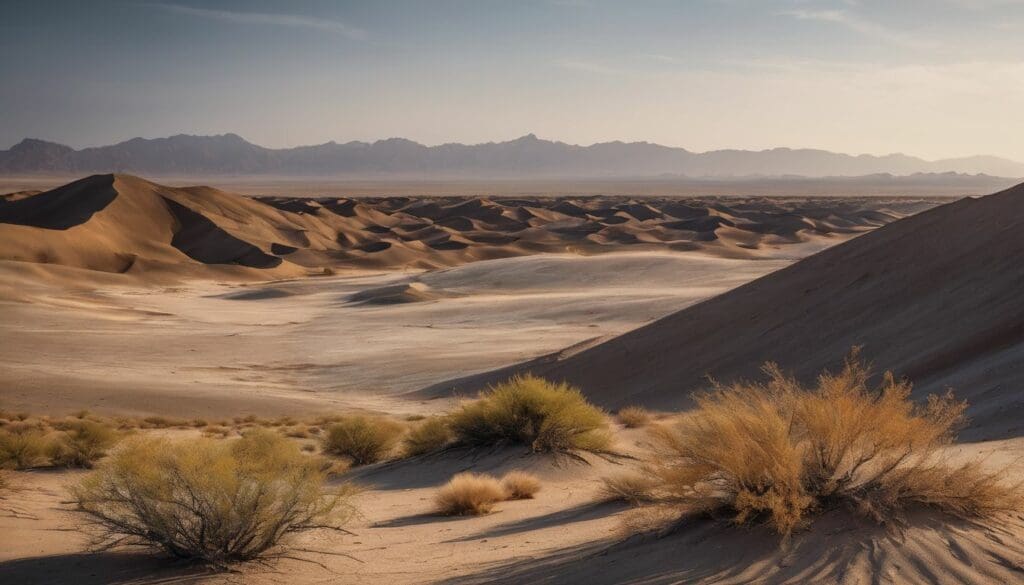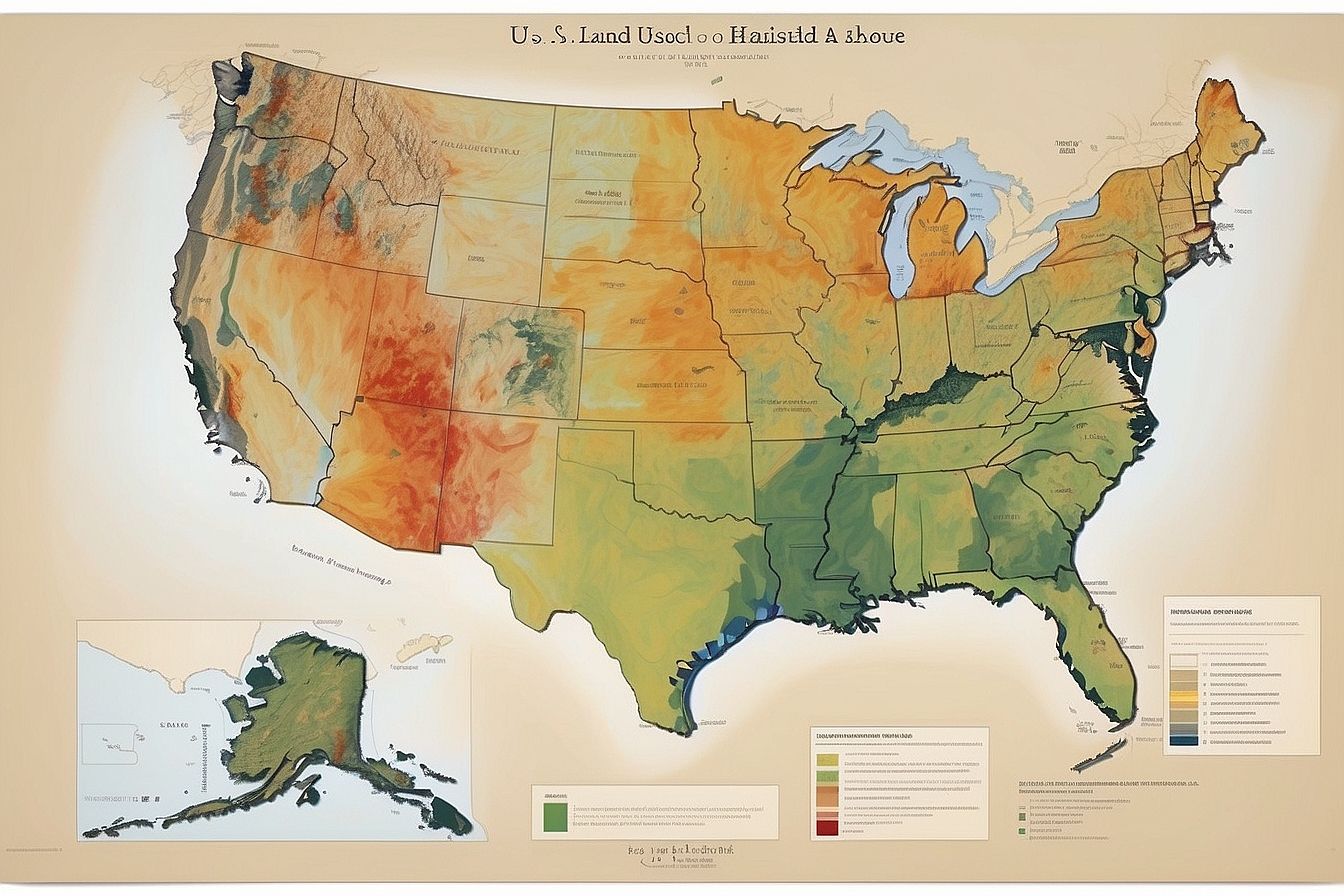As the Earth continues to warm, the insidious spectre of desertification transforms once verdant landscapes into lifeless swathes. It’s not a distant nightmare; it’s a reality that touches us all, knowing full well that 12 million hectares of once thriving land fall victim to desertification each year.
Our latest insights offer practical steps for stemming this silent onslaught and reinvigorating our imperilled ecosystems. So let’s delve in – every single patch of green we can salvage makes a world of difference!
Key Takeaways
- Desertification isn’t simply the spread of deserts but involves fertile land turning barren, mainly due to climate change and human activities such as deforestation and unsustainable farming.
- Crucial regions including Sub – Saharan Africa, Central Asia, Latin America, Australia, the Mediterranean, and North America are experiencing severe desertification which contributes significantly to greenhouse gas emissions by releasing carbon dioxide and methane from degraded soils.
- Desertification exacerbates climate change through feedback loops where vegetation loss leads to less carbon sequestration; this intensifies global warming that in turn promotes further desertification.
- The expansion of arid areas could reduce food productivity while increasing soil degradation; these effects threaten agricultural livelihoods and increase migration pressures creating socio-economic instability.
- Combating desertification involves sustainable land management practices like afforestation alongside socio-economic responses such as policy measures focusing on conservation and sustainable development.
Understanding Desertification
Understanding desertification is crucial in addressing this environmental challenge. The processes and drivers of desertification under climate change, as well as its status, trends, and future projections, provide valuable insight into the impact of desertification on our planet.
The nature of desertification
Desertification isn’t just about the spread of existing deserts. It’s a process where fertile land turns into barren landscapes, often due to climate change and human activities. We see healthy soil lose its life-giving properties as it erodes away, making it tougher for plants to grow.
This degradation can be triggered by droughts, deforestation, and unsustainable farming practices.
As desert-like conditions creep in, ecosystems decline dramatically. We face serious issues like water scarcity and reductions in food production which threaten local communities’ survival.
Such environmental challenges force people to leave their homes or adapt to much harder living conditions. Desertification is an ongoing battle against the loss of precious land that sustains biodiversity and human livelihoods alike.
Processes and drivers of desertification under climate change
As we delve into the processes and drivers of desertification under climate change, it becomes evident that increasing temperatures play a significant role in exacerbating soil erosion and land degradation.
Vegetation loss, fertile soil depletion, and water source depletion are also key drivers of desertification. These changes not only lead to a reduction in food production but also contribute to population displacement in dryland areas.
Moreover, aridification and environmental degradation further intensify desert expansion, resulting in ecosystem decline.
Status and trends of desertification
We’re witnessing an alarming trend of desertification that’s reshaping the landscape of our planet. In the table below, we summarise this concerning progression.
| Region | Status | Trend |
|---|---|---|
| Sub-Saharan Africa | Severe land degradation | Accelerating due to over-cultivation and deforestation |
| Central Asia | Largely affected | Agriculture and overgrazing driving desertification |
| Latin America | Increasing hotspots | Land use changes and climate variability worsening conditions |
| Australia | Expanding desert areas | Intensified by droughts and unsustainable land practices |
| Mediterranean | Critical water scarcity | Desertification magnified by rising temperatures |
| North America | Emerging concerns | Water management issues contributing to desert spread |
With these trends in mind, we turn our focus on how desertification feeds into the larger issue of climate change.
Future projections of desertification
As we look to the future, projections indicate that desertification will continue to pose significant challenges. The expansion of arid and semi-arid areas is expected to lead to further food production reduction and dryland degradation.
Additionally, ongoing soil carbon release and fertile soil loss will exacerbate these issues, impacting both natural ecosystems and human communities. These trends emphasise the urgent need for proactive measures to address desertification and its far-reaching consequences in order to mitigate its impact on climate change.
Furthermore, future projections suggest an escalation in food production reduction due to desertification, highlighting the critical importance of implementing effective strategies for sustainable land management.
The Impact of Desertification on Climate Change
Desertification contributes to greenhouse gas emissions and creates feedback loops that exacerbate climate change, impacting natural and socio-economic systems. To learn more about how desertification is affecting climate change, read on.
Desertification’s contribution to greenhouse gas emissions
Desertification significantly contributes to greenhouse gas emissions through the release of carbon dioxide and methane from degraded soils. As vegetation cover diminishes due to desertification, the organic matter in the soil is exposed to decomposition, leading to increased CO2 emissions.
Additionally, the drying out of wetlands during desertification results in the emission of methane, a potent greenhouse gas. These processes exacerbate climate change, creating a feedback loop that further accelerates desertification and global warming.
In order to address this issue effectively, it is essential for us to understand these interconnected processes and promote sustainable land management practices. By restoring vegetation cover and protecting soil health, we can mitigate greenhouse gas emissions associated with desertification while also bolstering resilience against climate change impacts on ecosystems and communities.
Feedback loops and their effects
Feedback loops occur when the impacts of desertification contribute to further environmental degradation. As arid lands expand due to climate change, the loss of vegetation and soil fertility leads to decreased carbon sequestration, exacerbating greenhouse gas emissions.
This contributes to a feedback loop in which desertification intensifies climate change, leading to even more severe desertification. The effects ripple through ecosystems, impacting biodiversity and natural resources while also affecting socio-economic systems by reducing food security and livelihood opportunities for local communities.
As desertification perpetuates these feedback loops, the need for effective action becomes increasingly urgent. Understanding these effects is crucial in developing strategies that not only mitigate current impacts but also prevent future escalation.
Impacts on natural and socio-economic systems
Desertification has severe impacts on natural and socio-economic systems. It leads to soil degradation, reduced biodiversity, and water scarcity, affecting ecosystems and agricultural productivity.
This loss of fertile land also threatens the livelihoods of communities that depend on agriculture for their sustenance. Additionally, desertification exacerbates poverty and social instability in affected regions, disrupting local economies and increasing migration pressures.
Socio-economically, desertification contributes to increased healthcare costs due to dust-related respiratory illnesses and malnutrition. Furthermore, it hampers tourism potential as degraded landscapes are less attractive for visitors.
Future projections of impacts
Considering the impacts on natural and socio-economic systems, future projections indicate that desertification will continue to exacerbate environmental degradation, leading to dwindling water resources, reduced agricultural productivity, and increased vulnerability of communities.
This ongoing trend is expected to heighten competition for resources and spark conflicts in already fragile regions. The projected increase in extreme weather events due to climate change will further amplify the severity of desertification’s impact on ecosystems and human well-being.
Furthermore, as desertification encroaches on habitable land, displacement and migration patterns are anticipated to intensify, placing additional strain on infrastructure and social services.
Combating Desertification and Climate Change
– Implementing sustainable land management practices, such as afforestation and soil conservation, can help combat desertification and mitigate the impacts of climate change. Additionally, socio-economic responses and policy measures are crucial in addressing the root causes of desertification and promoting resilience in affected communities.
On-the-ground solutions
We can combat desertification through on-the-ground solutions such as:
- Implementing sustainable land management practices to improve soil health and prevent erosion.
- Promoting reforestation and afforestation initiatives to restore degraded landscapes and increase carbon sequestration.
- Enhancing water conservation and efficient irrigation techniques to sustainably manage limited water resources in arid areas.
- Encouraging sustainable agricultural practices, such as agroforestry and crop diversification, to enhance food security while preserving the environment.
- Supporting community – based conservation efforts that empower local communities to protect and restore ecosystems.
Socio-economic and policy responses
As we shift our focus from on-the-ground solutions to addressing desertification and climate change, it’s crucial to consider the socio-economic and policy responses. The implementation of robust policies aimed at land management, conservation, and sustainable development plays a pivotal role in combating desertification.
By promoting economic diversification in affected regions through investments in alternative livelihoods such as eco-tourism or renewable energy projects, communities can reduce their reliance on vulnerable ecosystems.
Policy measures are essential for preventing land degradation by regulating land use practices while encouraging sustainable agriculture techniques and reforestation efforts. Additionally, integrating local knowledge systems with scientific expertise is vital for fostering inclusive governance structures that empower communities to take an active role in the conservation of their environments.
Limits to adaptation and potential for mitigation
Adapting to desertification presents challenges due to its complex and pervasive nature. Limitations arise in the ability of natural ecosystems and human communities to adjust to rapidly changing conditions.
However, mitigation efforts offer potential solutions that can help slow or reverse the process. Harnessing sustainable land management practices, such as reafforestation and soil conservation, along with tailored policies, holds promise for mitigating the impacts of desertification.
By addressing unsustainable land use and promoting resilient agricultural methods, we can work towards minimising further degradation and fostering a more sustainable future.
Conclusion
In conclusion, desertification poses a significant threat to our environment under the influence of climate change. It leads to widespread impacts on ecosystems and societies, exacerbating the challenges we face.
Taking action is crucial in addressing this issue and combating its effects before they become irreversible. We must work together to implement effective strategies that protect our landscapes and preserve biodiversity for future generations.
FAQs
1. What is desertification?
Desertification is the process where fertile land becomes a desert due to climate change, over-farming, deforestation and drought.
2. How does climate change lead to desertification?
Climate change contributes to extreme weather patterns like droughts and heats up the earth’s surface, both of which can cause fertile soil to lose its moisture and nutrients leading it towards becoming barren land.
3. Are humans responsible for desertification?
Yes, human activities such as clearing trees for agriculture or construction without sustainable practices can speed up soil degradation, increasing the risk and spread of desertification.
4. Can we stop or reverse desertification related to climate change?
By managing water sources wisely, planting more trees to prevent soil erosion, and adopting farming practices that keep the ground healthy, we aim to control or possibly reverse some effects of desertification caused by climate change.





